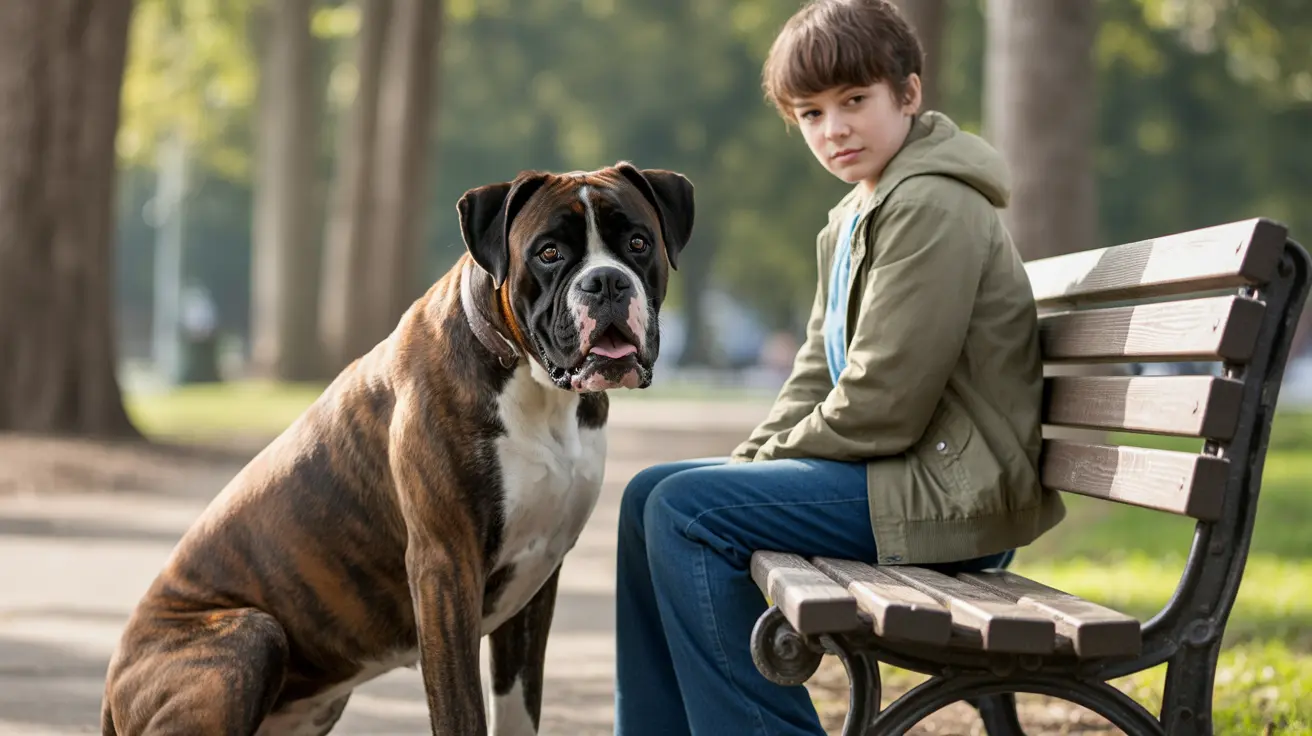How to Manage Fear of Dogs During Encounters: A Complete Guide for Everyone
Fear of dogs, medically known as cynophobia or canophobia, affects approximately 7-9% of people at some point in their lives. This overwhelming anxiety can transform a simple walk through the neighborhood into a stressful ordeal, causing individuals to avoid parks, sidewalks, and social situations where dogs might be present. Whether you're someone who experiences intense fear around dogs or a dog owner seeking to create more comfortable interactions for everyone, understanding how to manage fear of dogs during encounters is essential for building a more inclusive community.
The challenge of managing fear during dog encounters extends beyond the fearful individual—it requires awareness and cooperation from dog owners, understanding of canine behavior, and practical strategies that work in real-world situations. This comprehensive guide will provide evidence-based techniques, practical tips, and expert insights to help both fearful individuals and dog owners navigate these encounters with confidence and respect.
Understanding Cynophobia: More Than Just Being Scared
Cynophobia, deriving from the Greek word "cyno" meaning dog, represents an extreme and overwhelming fear that goes far beyond normal caution around unfamiliar animals. Unlike general wariness, this anxiety disorder can trigger intense physical and emotional responses even when thinking about dogs, seeing pictures of dogs, or hearing barking in the distance.
The condition commonly develops in childhood but can emerge at any age, with women statistically more likely to experience this phobia. Risk factors include depression, generalized anxiety disorder, obsessive-compulsive disorder (OCD), panic attacks, family history of phobias, and prior traumatic experiences with dogs. Interestingly, the fear often stems from childhood associations rather than actual dog attacks, and people with cynophobia don't necessarily need direct contact with a dog to experience anxiety.
Recognizing the Symptoms
Physical symptoms of cynophobia during dog encounters can include intense fear, panic attacks, excessive sweating, rapid heartbeat, chest pain, shortness of breath, dizziness, nausea, and difficulty swallowing. Emotional responses may involve crying, screaming, feelings of dread, and an overwhelming urge to flee. These symptoms can manifest even when seeing a leashed dog from a distance, highlighting the severity of this condition.
The Science Behind Fear: How Dogs Sense Human Emotions
Dogs possess remarkable abilities to detect human emotions through multiple channels, including pheromones, body language, and vocal cues. When someone experiences fear, their body releases chemical signals that dogs can detect, potentially influencing the dog's behavior toward fearful individuals. This biological reality explains why some dogs may approach fearful people differently or why certain encounters feel more intense.
Studies have shown that fearful or emotionally unstable people are more prone to dog bites, possibly due to misreading dog body language or inadvertently sending conflicting signals. This research underscores the importance of understanding both human fear responses and canine communication for safer interactions.
Immediate Strategies for Managing Fear During Encounters
For Fearful Individuals
When encountering a dog unexpectedly, your immediate response can significantly impact the situation. Stay calm and avoid direct eye contact with the dog, as this can be perceived as a challenge in canine communication. Regulate your breathing through slow, deep breaths to help control your body's fear response and reduce the pheromones that dogs can detect.
Resist the urge to run or shout, as these actions can provoke a chase response or excitement in the dog. Instead, move slowly and deliberately. If possible, change your walking path or cross to the other side of the street—this is a completely valid option to reduce stress and avoid an uncomfortable situation.
For Dog Owners
Recognizing signs of fear in others is crucial for responsible dog ownership. When you notice someone appears uncomfortable, nervous, or is actively avoiding your dog, immediately respond by shortening the leash, calling your dog close to your side, or moving to give the person more space. These simple actions can significantly reduce anxiety for fearful individuals.
Avoid dismissive comments like "don't worry, he's friendly" as this minimizes the person's legitimate fear. Instead, acknowledge their discomfort and take proactive steps to create distance. Your dog's friendliness doesn't eliminate another person's right to feel safe and comfortable in public spaces.
Understanding Dog Body Language for Safer Interactions
Learning to interpret dog body language correctly can prevent misunderstandings and reduce anxiety during encounters. Calm dogs typically have relaxed body posture, soft eyes, and gentle tail movements. Signs of potential concern include stiff body posture, direct staring, raised hackles, or rapid, high tail wagging.
Large dog breeds are often calmer due to higher threshold levels, meaning they're less likely to react impulsively to stimuli. However, fear can still occur with any dog regardless of size, and individual personality matters more than breed characteristics in most encounters.
Professional Treatment and Long-Term Management
Exposure Therapy: The Gold Standard
Exposure therapy is considered the most effective treatment for cynophobia, with over 90% of participants experiencing significant symptom reduction that endures years after treatment. This evidence-based approach involves gradual and systematic exposure to dogs, often starting with imagining encounters, viewing images or videos, holding toy dogs, and slowly progressing to approaching and interacting with real dogs.
The process might begin with virtual reality exposure, allowing individuals to experience dog encounters in a completely controlled environment. Professional guidance ensures that exposure is gradual, respects client consent and readiness, and makes the process positive and empowering rather than overwhelming.
Cognitive Behavioral Therapy (CBT)
CBT helps change fearful thoughts and reactions by challenging unhelpful beliefs about dogs and dog encounters. This approach combines exposure therapy with cognitive restructuring, anxiety management techniques, and behavioral experiments. Learning about dog behavior through CBT fosters a sense of control and predictability during future encounters.
Supportive Therapies
Additional therapeutic approaches include psychotherapy, hypnotherapy, mindfulness practices, yoga, breathing exercises, and meditation. These techniques can be particularly helpful for managing anxiety symptoms and building overall emotional resilience.
Practical Exercises for Building Confidence
For individuals working to overcome their fear, gradual exposure exercises can be conducted safely under professional guidance or with trusted support. Start by understanding your personal fear triggers—is it the sound of barking, sudden movements, or the unpredictability of dog behavior?
Begin with controlled exposure to calm, well-behaved dogs in structured environments. Practice relaxation techniques like deep breathing and meditation before and during these exercises. Be aware of your own body language, as tense or fearful postures can influence how dogs respond to you.
Creating Respectful Interactions in Public Spaces
Legal and Social Responsibilities
Both fearful individuals and dog owners must take fear seriously and act respectfully to ensure peaceful encounters. Dog owners have legal and social responsibilities toward fearful pedestrians, including maintaining control of their pets and being mindful of others' comfort levels in shared spaces.
Understanding that cynophobia is a legitimate medical condition, not simply a preference or character flaw, helps create more empathetic interactions. Dog owners can contribute to a more inclusive environment by training their dogs to behave calmly around people and by being attentive to social cues indicating discomfort.
The Path to Recovery and Improved Quality of Life
Without treatment, severe cynophobia can lead to social isolation, avoidance of outdoor activities, and decreased quality of life. Some individuals may develop agoraphobia as their world becomes increasingly restricted by their fear. However, the prognosis for cynophobia is generally good, especially with appropriate therapy.
Recovery is possible and often highly successful. Many individuals who complete evidence-based treatment programs report not only reduced fear but also improved confidence and a greater sense of freedom in their daily lives. The combination of exposure therapy, CBT, and supportive techniques enables affected individuals to regain control and live without the constraints of overwhelming fear.
Frequently Asked Questions
- Q: How can I tell if my fear of dogs is severe enough to need professional help?
Consider seeking professional help if your fear of dogs significantly impacts your daily life, causes you to avoid places where dogs might be present, triggers intense physical symptoms like panic attacks, or interferes with your social relationships and activities. Healthcare providers can assess the severity and recommend appropriate treatment options.
- Q: What should I do if I encounter an unleashed dog while experiencing fear?
Stay calm and avoid running, which can trigger a chase response. Don't make direct eye contact with the dog. Move slowly and steadily away from the area if possible. If the dog approaches, remain still and avoid sudden movements. Call for the owner if visible, or contact local animal control if the situation feels unsafe.
- Q: How long does exposure therapy typically take to show results?
The timeline varies depending on the severity of the phobia and individual responses to treatment. Some people notice improvements within a few sessions, while others may need several months of consistent therapy. Studies show that over 90% of participants experience significant symptom reduction that can last for years after completing treatment.
- Q: Can medications help with cynophobia?
While medications may help manage anxiety, depression, or panic attack symptoms associated with cynophobia, they are not considered primary treatments. Exposure therapy and CBT remain the gold standard approaches. Medications are typically used adjunctively to support the therapeutic process when necessary.
- Q: Is it possible to overcome cynophobia completely?
Yes, many people successfully overcome cynophobia through evidence-based treatment approaches. Complete recovery is possible, though some individuals may always maintain a healthy level of caution around unfamiliar dogs. The goal is to reduce fear to manageable levels that don't interfere with daily life.
- Q: How can dog owners help people with cynophobia feel more comfortable?
Dog owners can help by keeping dogs on short leashes in public spaces, being attentive to signs of discomfort in others, creating distance when someone appears fearful, avoiding dismissive comments about their dog's friendliness, and training their dogs to respond calmly to various social situations.
- Q: What's the difference between normal caution around dogs and cynophobia?
Normal caution involves reasonable wariness around unfamiliar animals and doesn't significantly impact daily life. Cynophobia involves overwhelming fear that triggers intense physical and emotional responses, causes avoidance of places where dogs might be present, and interferes with normal activities and social interactions.
Conclusion
Managing fear of dogs during encounters requires understanding, patience, and practical strategies that benefit both fearful individuals and dog owners. Cynophobia is a legitimate medical condition that affects millions of people, but it's also highly treatable through evidence-based approaches like exposure therapy and cognitive behavioral therapy. The key to successful encounters lies in mutual respect, awareness of the condition's severity, and commitment to creating inclusive public spaces.
Whether you're working to overcome your own fear or supporting someone who experiences anxiety around dogs, remember that recovery is possible and professional help is available. By combining practical encounter strategies with long-term treatment approaches, individuals with cynophobia can regain their freedom and confidence while dog owners can contribute to a more understanding and accommodating community for everyone.





